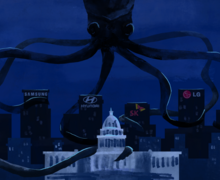Smith: Syracuse football’s failures have cost it a seat at the big table
Meghan Hendricks | Photo Editor
Poor decisions will keep the Orange out of college football’s power conferences in the future.
Get the latest Syracuse news delivered right to your inbox. Subscribe to our sports newsletter here.
The year is 1987. And for the first time in nearly three decades, Syracuse football is in national championship contention. SU has a quarterback in the Heisman Trophy race, plays regularly in front of a packed crowd in the Carrier Dome and will appear in the Sugar Bowl on New Year’s Day.
Now think about 2037. The Atlantic Coast Conference’s TV contract has just expired, there’s only two power conferences and the Orange are left outside the group of college football powerhouses. They have no access to a national championship or any major bowl games and play a slate of games against other programs left behind in realignment. Syracuse’s TV revenue pales in comparison to the Big Ten teams — like Rutgers, Penn State and Maryland — it beat up on 50 years prior.
Football drives realignment. After Texas and Oklahoma bolted to the Southeastern Conference in 2021 and USC and UCLA announced they would join the Big Ten this summer, Syracuse is facing a harsh reality given the current state of its football program.
“I don’t know if that’s inevitable or not,” Director of Athletics John Wildhack said in July when asked if SU could be left out of a power conference. “It clearly could go that way.” When asked for further comment from Widhack about realignment, an SU spokesperson redirected a comment request to the ACC.
The Big Ten has already cashed in, signing a seven-year TV deal worth over $7 billion that will begin next year. The SEC’s next TV contract will begin in 2024, and both leagues are expected to hand out at least $100 million — and possibly more if they add other schools — to each member before the end of the decade.
No other conference will come remotely close. At the end of the ACC’s TV deal in 2036, prominent members will flee into the secure arms of the SEC and Big Ten. The Power Five will officially become the Power Two. And Syracuse will be on the outside looking in.
But Syracuse would be coveted in conference realignment — like it was during the 1990s and 2000s — if its football program was more successful right now. The Orange are not highly coveted, though, because they’ve been consistently mediocre for the last 20 years. The combination of poor decisions by past and present university leaders in coaching and realignment, along with a general lack of investment into the program relative to other major competitors, has made being left out of a power conference a reality.
Syracuse will only be able to reminisce and wonder ‘what if?’ What if they accepted a Big Ten offer when it was on the table? What if the Orange hadn’t been one of the worst power conference teams from 2002-21? What if Paul Pasqualoni wasn’t fired, Greg Robinson was never hired or Doug Marrone didn’t leave for the NFL? What if the school invested more into its football program, increased coaching salaries and built a football-only practice facility before 2015? What if Syracuse was a Power Two school and not a Power Zero?

Jacques Megnizin | Design Editor
Reports say that every Power Five school not in the SEC has been frantically reaching out to the Big Ten. The only thing keeping the ACC together is its grant of rights agreement, which means the conference owns each school’s TV rights until 2036. Wildhack declined to say if he’s spoken to either the SEC or Big Ten, but believes keeping the ACC together through the grant of rights deal is “the trail to follow.”
But once that agreement expires, the ACC will be a rundown version of its old self at best. At worst, it won’t exist. North Carolina, Duke, Virginia and even Georgia Tech bring large media markets, AAU membership and are located in areas where more and more people are moving to. Syracuse will lack a power conference home and won’t be invited to the Big Ten.
What happens on the football field is the primary factor in realignment. The two-fold decision to fire Pasqualoni and hire Robinson was a clear mistake that set Syracuse back decades, and allowed Rutgers, a school which had essentially no success in football, to become a national contender in the 2000s. That eventually positioned it to earn a Big Ten invite in 2012. Hiring Scott Shafer to replace Marrone was not a sound move either, and Dino Babers’ results have been mixed through six seasons.
After being an attractive school for the ACC a decade ago, SU is more of a footnote in the league now. It has failed to compete for conference titles in football or men’s basketball since arriving in 2013.
Investing properly has also been an issue — Marrone was vastly underpaid compared to comparable head coaches during his time at SU, and Babers isn’t exactly one of the nation’s highest paid head coaches even after his contract extension. In the ever-important area of indoor practice facilities, Syracuse trailed for years, watching as Big East rivals West Virginia and Connecticut built their own facilities, while sharing space in Manley Field House (which couldn’t even hold a full-length football field).
Soon, SU’s seven-year-old Ensley Athletic Center may not be attractive to potential players, and the Orange have already struggled in recruiting. Those recruits certainly aren’t attracted by the fact that SU is the only ACC program without a full-time nutritionist either. Even current players aren’t too pleased with that.
Wildhack said SU is focused on building infrastructure for its athletic programs, noting the Lally Athletics Complex and a new building for the football team as improvements that can help the Orange compete. It’s difficult to predict if those upgrades will make a tangible impact, but they are definitely moves that could’ve been made years ago.
“We’re trying to do everything we can to best position Syracuse for success,” Wildhack said.
Wildhack wouldn’t go into potential options for SU should it be left out of a power league. If it does happen, Syracuse should unite with other regional schools in the same position as it (West Virginia, Boston College and Pitt all come to mind) and sign a TV contract that can give members enough cash to still keep them somewhat relevant nationally. An emphasis on proximity, thus creating shorter road trips and stronger rivalries, could benefit SU and the sport at large.

Jacques Megnizin | Design Editor
But the Orange want to compete on the biggest stage. Over the next 20 years, in the absence of a miracle, local schools that Syracuse used to consider rivals, competitors, even teams it could regularly blow out, will significantly outpace SU in revenue, recruiting and prestige. 1987 was a long time ago, but 2037 is swiftly approaching. And while the Power Two will thrive then, the Orange’s once-proud football program will be in retreat, wondering ‘what if?’
Connor Smith is a senior staff writer at The Daily Orange, where his column appears occasionally. He can be reached at csmith49@syr.edu or on Twitter @csmith17_.
Published on September 1, 2022 at 12:17 am





